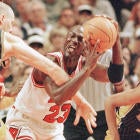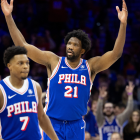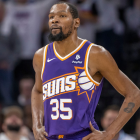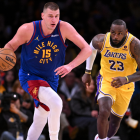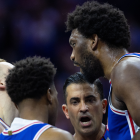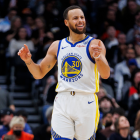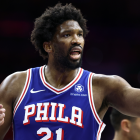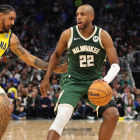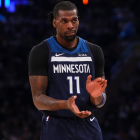The 1997-98 Indiana Pacers are about as unspectacular on paper as a conference finalist gets. Nobody on the roster averaged 20 points per game, yet they had the NBA's fourth-ranked offense. They had no All-Defense selections, yet they finished with the fifth-ranked defense in the league. They may have had two All-Stars, but when one of them sneaks in on 16.7 points, 6.9 rebounds and unspectacular individual defensive numbers, nobody would mistake them for a superteam.
Still, those Pacers won 58 games and pushed Michael Jordan to the absolute brink, coming six points away from toppling the Chicago Bulls' dynasty and reaching the NBA Finals. The only other team to even earn a Game 7 against Jordan during a championship season -- the 1991-92 New York Knicks -- got rocked by 29 points once they got there. No team has ever come closer to depriving Jordan of a trophy, and the Pacers certainly didn't do it through raw talent.
Without brawn, they needed to win with brains. Fortunately, that is something that Larry Bird has in abundance. After years of playoff disappointments, Bird took over as head coach for the Pacers in the summer of 1997 and reinvented them into a harbinger of the basketball revolution that would soon come, adopting many of the modern principles that teams take for granted today.
Prelude: One Larry enters, another Larry exits
Larry Brown is a Dean Smith-approved basketball purist. So old school that the three professional teams he played for no longer exist, Brown's hard-driving personality tends to wear thin on players. There's a reason his average professional head-coaching stint was only 3.1 years, and by his fourth in Indiana, one in which the Pacers missed the playoffs for the first time since 1989, his players had grown entirely sick of him.
"Anything after Larry Brown was easy," Pacers center Rik Smits told Mike Montieth for his excellent oral history of that team. "I liked Larry as a person but he was a bear to deal with on the basketball court. Nothing was ever good enough."
That made Bird's player-centric style a breath of fresh air. While he was demanding in terms of conditioning and punctuality, his four-word slogan made his feelings on coaching clear: "It's a player's game," Bird often said. That was lost in Brown's rigid approach to basketball. Despite employing Reggie Miller, the NBA's best shooter at the time, Indiana never finished better than 24th in 3-point attempts per game during his tenure.
Forget about analytics, the Pacers needed a dose of common sense. Bird's light touch provided plenty of it.
Indiana's offense
Bird didn't just empower his players. He allowed his assistants nearly unfettered control over their domains, a move that paid major dividends for the talent on his bench. His offensive coordinator was a young Rick Carlisle, and his fingerprints are all over the style run by the '97-98 Pacers. A cursory viewing of the Eastern Conference finals displays one of his favored tactics: using the post as a conduit for 3-pointers by drawing double-teams. Watch how patient Dale Davis is in drawing Scottie Pippen away from Mark Jackson.
Indiana's shot-profile improved with each passing year under the Bird-Carlisle tandem, culminating in a 1999-00 season in which it led the NBA in made 3-pointers and finished fourth in attempts. The 1997-98 group wasn't quite as analytically-inclined, finishing 12th in attempts in what was still a massive jump from 24th in Brown's final year. Any ground the Pacers surrendered in terms of shot selection was more than made up for by embracing another Carlisle principle: splitting the load between multiple ball-handlers.
No Pacer averaged 20 points per game, but seven averaged at least eight. Jackson led the way with 8.7 assists per game, and Travis Best chipped in another 3.4, but the wild card for Indiana was a young Jalen Rose. A jumbo point guard, Rose's presence discombobulated defenses that weren't used to multiple attackers sharing the court at once.
Indiana's most modern offensive tactic actually came on the glass. Brown's 1996-97 Pacers finished 11th in offensive rebounding rate, but Bird adopted a stance that Doc Rivers has since popularized: abandoning the offensive boards entirely. The 1997-98 Pacers finished 28th in offensive rebounding rate and reaped the rewards on defense. Rather than crash the boards, Bird's Pacers dedicated their energy to transition defense and, as a result, managed to slow the game down to a crawl. They finished 26th in pace, a necessity considering their aging roster, and that translated to some of the most mind-blowing defensive metrics in NBA history.
Indiana's defense
The 1997-98 Pacers hit the holy grail of modern defense. Only 25.4 percent of opponent shots came within three feet of the rim, the lowest mark in the NBA, and only 13.4 percent of their shots were 3-pointers, also the lowest in the NBA. No other team has done both in the same season, according to Basketball-Reference's data. It is the best opposing shot profile a team could ask for: the Pacers forced opponents to minimize the two most valuable shots in basketball.
So how did they do it? Punting on offensive rebounding helped. While not athletic enough to get into track meets with younger, faster teams, the Pacers could smother fast breaks through the numbers that strategy allowed.
Indiana's sheer size played an enormous role as well. Parking the 7-4 Smits at the basket was a fairly effective deterrent, and when teams used the pick-and-roll to draw him away from the hoop, the Pacers usually had a spare rim-protector in either Dale or Antonio Davis to rotate over to the basket. They supplemented those bigs by ignoring non-shooters on the perimeter in the name of extra rim-protection. Mark Jackson often left Ron Harper alone during the Eastern Conference finals to serve as an extra line of defense at the basket, happily giving away shots he didn't expect to go in.
There's a shred of irony in Steve Kerr being the coach to pioneer this tactic in the modern game. He watched Indiana do it firsthand in this series. Defending players like Kerr himself was a priority for the Pacers. While they feasted on 3-pointers generated by post-doubles, they themselves avoided doubling at all costs, even against Michael Jordan, instead staying home on perimeter shooters in an effort to limit the damage of mismatches to only two points.
Indiana's length similarly contributed to that effort. Aside from their point guards, every Pacer in Bird's playoff rotation measured at least 6-6. Most were bigger. Players like Miller, Rose and the aging Derrick McKey may not have been elite defenders at that point, but they were long enough to contest just about anything from behind the arc. While opposing 3-point percentage can be fairly random statistically speaking, it's worth noting that opponents shot only 31.6 percent from behind the arc against the Pacers that season, the worst mark in the NBA. The Bulls were held to only 32.5 percent in the conference finals. Indiana's length was problematic to opponents.
Length was hardly emphasized in the way that is today, but Indiana's modernity in 1998 was its greatest selling point. Were it not for a few key flaws and Jordan's excellence, the Pacers may well have ridden their novel style all the way to a championship.
So what went wrong?
Well for starters, Phil Jackson is a pretty good coach in his own right. He started Toni Kukoc at power forward for most of this series to combat Indiana's flawless defensive shot profile. His spacing proved critical. He made three huge 3-pointers in Game 7.
But in truth, this series didn't come down to what the Pacers did wrong, but what the Bulls did right. The other team just happened to have a cheat code. Michael Jordan breaks analytically-inclined defenses. Shots that would be grossly inefficient for normal players are just fine for him.
Jordan averaged 31.7 points per game in the ECF on 46.7 percent shooting. Indiana's strategy not to double Jordan worked. His teammates largely didn't get clean looks from behind the arc. Jordan just punished the Pacers so thoroughly from the post that it didn't matter. The Pacers picked the right poison and still died.
The proof of that lies in how they defended Jordan's pick-and-roll. The Pacers eschewed traditional drop pick-and-roll coverage, allowing the slow-footed Smits to either double Jordan off of the screen or meet him coming around it. This cut off Jordan's preferred mid-range jumper, but it also forced Smits to scamper back into position afterward. Guess who won the foot race between Rik Smits and Michael Jordan?
The Bulls spammed the Jordan-Luc Longley pick-and-roll relentlessly down the stretch of Game 7, and while the dunk stands out, the most common outcome was a foul. With Smits lost on the perimeter, someone else had to rotate to meet Jordan at the basket, where he took advantage of them being out of position. Jordan made 10 of his 15 free-throw attempts in Game 7.
Where Indiana truly lost this series, though, was on the boards. In the Bulls, the Pacers had finally run into a team capable of punishing them for the tactically brilliant but risky strategies on which their success was built. Chicago finished the series with 44 more offensive rebounds than the Pacers, and Harper took advantage of the space Indiana left him to come up with 15 of his own throughout the series.
And that was that. A year's worth of innovation down the drain thanks to Jordan's brilliance. Plenty of teams from the 1990s can sympathize, but there is something especially tragic about Indiana's poor timing. They escaped Jordan's shadow in 1999 only to fall victim to Larry Johnson's infamous four-point play. When they finally broke through and reached the Eastern Conference finals, Kobe Bryant and Shaquille O'Neal were waiting for them.
Bird called it quits after three seasons, suggesting that no head coach can hold a team's attention much longer. He largely held true to his word once he took over as the team's top decision-maker, firing extremely well-respected coaches like Carlisle and Frank Vogel at the five-year mark. Most of the momentum Bird built in his brief tenure was squandered by Isiah Thomas. The league caught up to Indiana, and the Pacers are still without an NBA championship. At least they can take solace in coming closer than anyone to ending the Bulls dynasty. Reggie Miller really did almost retire Michael Jordan.













